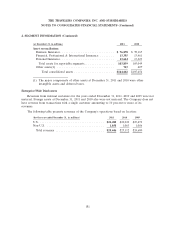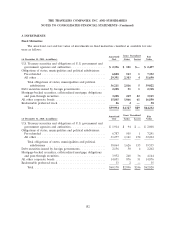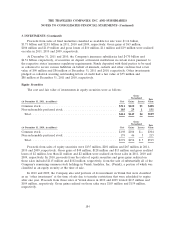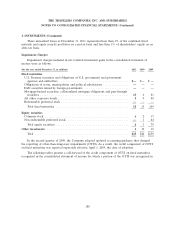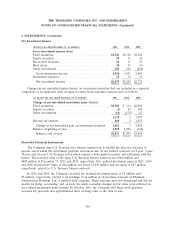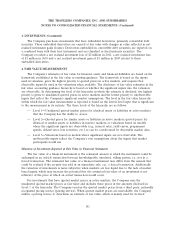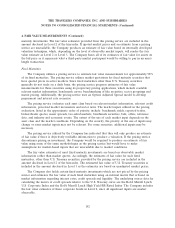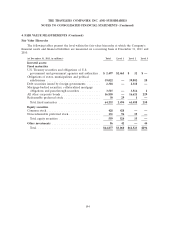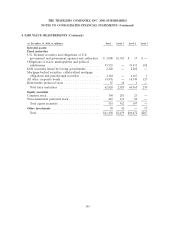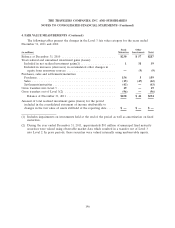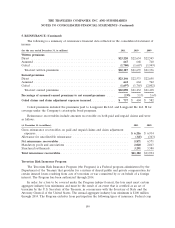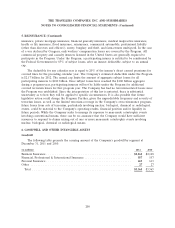Travelers 2011 Annual Report Download - page 203
Download and view the complete annual report
Please find page 203 of the 2011 Travelers annual report below. You can navigate through the pages in the report by either clicking on the pages listed below, or by using the keyword search tool below to find specific information within the annual report.THE TRAVELERS COMPANIES, INC. AND SUBSIDIARIES
NOTES TO CONSOLIDATED FINANCIAL STATEMENTS (Continued)
3. INVESTMENTS (Continued)
The Company purchases investments that have embedded derivatives, primarily convertible debt
securities. These embedded derivatives are carried at fair value with changes in value reflected in net
realized investment gains (losses). Derivatives embedded in convertible debt securities are reported on
a combined basis with their host instrument and are classified as fixed maturity securities. The
Company recorded a net realized investment loss of $2 million in 2011, a net realized investment loss
of $1 million in 2010 and a net realized investment gain of $1 million in 2009 related to these
embedded derivatives.
4. FAIR VALUE MEASUREMENTS
The Company’s estimates of fair value for financial assets and financial liabilities are based on the
framework established in the fair value accounting guidance. The framework is based on the inputs
used in valuation, gives the highest priority to quoted prices in active markets, and requires that
observable inputs be used in the valuations when available. The disclosure of fair value estimates in the
fair value accounting guidance hierarchy is based on whether the significant inputs into the valuation
are observable. In determining the level of the hierarchy in which the estimate is disclosed, the highest
priority is given to unadjusted quoted prices in active markets and the lowest priority to unobservable
inputs that reflect the Company’s significant market assumptions. The level in the fair value hierarchy
within which the fair value measurement is reported is based on the lowest level input that is significant
to the measurement in its entirety. The three levels of the hierarchy are as follows:
— Level 1—Unadjusted quoted market prices for identical assets or liabilities in active markets
that the Company has the ability to access.
— Level 2—Quoted prices for similar assets or liabilities in active markets; quoted prices for
identical or similar assets or liabilities in inactive markets; or valuations based on models
where the significant inputs are observable (e.g., interest rates, yield curves, prepayment
speeds, default rates, loss severities, etc.) or can be corroborated by observable market data.
— Level 3—Valuations based on models where significant inputs are not observable. The
unobservable inputs reflect the Company’s own assumptions about the inputs that market
participants would use.
Valuation of Investments Reported at Fair Value in Financial Statements
The fair value of a financial instrument is the estimated amount at which the instrument could be
exchanged in an orderly transaction between knowledgeable, unrelated, willing parties, i.e., not in a
forced transaction. The estimated fair value of a financial instrument may differ from the amount that
could be realized if the security was sold in an immediate sale, e.g., a forced transaction. Additionally,
the valuation of investments is more subjective when markets are less liquid due to the lack of market
based inputs, which may increase the potential that the estimated fair value of an investment is not
reflective of the price at which an actual transaction would occur.
For investments that have quoted market prices in active markets, the Company uses the
unadjusted quoted market prices as fair value and includes these prices in the amounts disclosed in
Level 1 of the hierarchy. The Company receives the quoted market prices from a third party, nationally
recognized pricing service (pricing service). When quoted market prices are unavailable, the Company
utilizes a pricing service to determine an estimate of fair value, which is mainly used for its fixed
191


